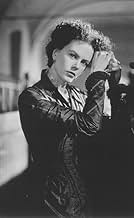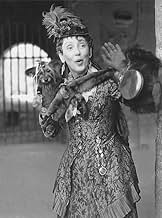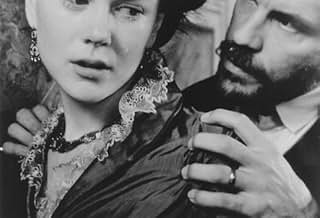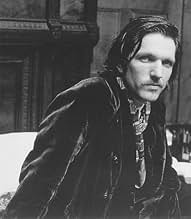NOTE IMDb
6,2/10
13 k
MA NOTE
Une jeune fille américaine hérite d'une fortune. Elle tombe dans une relation malavisée avec un artiste de confiance gentleman, dont la vraie nature acérée et avide transforme sa vie en cauc... Tout lireUne jeune fille américaine hérite d'une fortune. Elle tombe dans une relation malavisée avec un artiste de confiance gentleman, dont la vraie nature acérée et avide transforme sa vie en cauchemar.Une jeune fille américaine hérite d'une fortune. Elle tombe dans une relation malavisée avec un artiste de confiance gentleman, dont la vraie nature acérée et avide transforme sa vie en cauchemar.
- Nommé pour 2 Oscars
- 5 victoires et 15 nominations au total
Amy Lindsay
- Miss Molyneux #1
- (as Katie Campbell)
Histoire
Le saviez-vous
- AnecdotesFirst collaboration between director Dame Jane Campion and Nicole Kidman. However, it was Campion who discovered Kidman, where she, at the age of fourteen, was performing at Australian Theater for Young People and subsequently caught the eye of Campion.
- Gaffes(at around 47 mins) A horse carriage is passing through the shot from right to left. The crew with dolly-cam and equipment is clearly visible.
- Citations
Ralph Touchett: I love you but without hope.
- Crédits fousJane Campion thanks her family, Colin, Alice and Richard, for their generous support, suggestions and encouragement during the making of this film.
- Bandes originalesImpromptu in A Flat Major, Op 90 No. 4, D899
(1828)
Composed by Franz Schubert
Adapted for screen by Brian Lock
Performed by Jean-Yves Thibaudet (as Jean Yves Thibaudet)
Courtesy of Decca Records Company Ltd.
Commentaire à la une
I have watched Portrait of a Lady and I am very impressed by it. How I missed it in the first place I don't know. Sometimes I am wary of adaptations, of historical costume dramas, and even of Jane Campion, whose The Piano I avoided when it first came out because too many people I didn't particularly trust kept telling me I must see it. When I saw it finally, it was interesting. I don't find either Holly Hunter or Harvey Keitel particularly attractive people to look at, but I still recognized that the director had energy and talent.
No doubt about Barbara Hershey in Portrait. She is excellent, full of strength and conviction in her performance in this movie. She alone among the cast has the maturity and sophistication to exhibit complexity and self-doubt. The big questions are Nicole Kidman and John Malkovich. Both are strong, but both have limitations. Nicole is excellent in the opening sequences. You can accept her as a beautiful, energetic young woman with formidable eagerness, readiness, independence. What happens to her after her marriage to Osmond has gone sour is a little unclear. You have to guess. Did he waste all her money? Apparently that is the case; however, I didn't get that from the movie but from things I read by critics thoroughly familiar with the Henry James novel, some of whom say you can't really follow the movie without knowing the novel, which apparently is 52 chapters long and has a great deal more about all the characters, particularly Isabel Archer, than the movie tells us. If Isabel is now much less rich, that may explain Osmond's power over her. Another explanation would be 19th-century mores, lack of autonomy in the very mentality of women in those days. But this goes against the impression of James's novels in general and of Isabel in the movie. It must then be a kind of hypnotism. Osmond must hold Isabel subjugated through sheer perverse psychological will power, a kind of passive-aggressive domination that eventually becomes more aggressive. I don't think Nicole Kidman is quite equal to the complexity of the role toward the end. Her final scene with Ralph is overdone. She ruins it by overacting. If she didn't cry so much, the scene would be much more moving. Martin Donovan does hold back. It's hard to find fault with his performance at any point. He really makes Ralph Touchett interesting, someone you don't ever fully know, someone with hidden depth.
As for Malkovich, he isn't as repulsive throughout as some seem to think. I think they're reacting to the Malkovich we've seen in so many movies, playing essentially the same character over and over with variations of period, dress, economic status, and so forth. My best memory of him is as the Vicomte de Valmont in Stephen Frears' Dangerous Liaisons: the 18th-century polish gives him a mask of elegant neutrality, and at the same time, he is meant to be a wicked, reptilian monster from the start. As Osmond, he has to appear attractive to begin with---and he does, to a considerable degree. But we still find it difficult to follow what Isabel would see in him. This is the movie's fault more than it is his. We can certainly understand why Isabel would go to England and not be sure of returning to Florence.
This is only to focus on the main characters, and there are eight or nine others to account for. An interesting quality of Campion's movie is that we have to do some thinking---as one certainly does in reading Henry James---to understand these people. It's not always a fault that they're somewhat opaque---so are James's. I don't share some critics' dissatisfaction with Shelley Winters, Mary-Louise Parker, or Shelley Duvall. The American lack of polish they project seems just right for Henry James, who is so preoccupied with the contrast between Europeans and Americans. Valentina Cervi is good, though one may find it hard to understand how two Americans would have an Italian child. Viggo Mortensen is continually unsatisfactory and uninteresting; but he has been written as a completely boring character. We begin to wince when he reappears, because he never changes and is always rejected. John Gielgud of course is wonderful, and creates a thoroughly convincing character, though he appears only for a few minutes. Christian Bale, not always a very interesting actor, has the good looks and the eagerness to be perfect as the frustrated lover, Rosier. Memories of Withnail and I may tarnish the splendor of Richard E. Grant's Lord Warburton, but he's damned successful at giving off an aura of aristocratic restraint---terribly English. The casting is excellent, though it gets weaker as we move toward the top.
Wonderful photography doesn't make up for huge gaps in adapting a complex novel to the screen, but superior cinematography can be an enormous compensation and that's what Stuart Dryburgh unfailingly provides. Whatever shortcomings there are in the visual area must be blamed not on the very gifted Dryburgh but on the director and editor's final cut. It's true that the tilted camera in opening shots becomes obtrusive, but it wasn't a bad idea, just one that's been allowed to be a little overused. Nor is the use of trees or figures or balustrades intervening in a long shot at all a bad idea. It's good, because it loosens up the perfect period effect and makes it more realistic; but it's also been allowed to seem a little overdone. The use of Schubert's Death and the Maiden is too repetitious. The sweeping strings are sometimes excessive. Nonetheless the overall effect of sound and image is one of compelling beauty. (Ambient sound is often wonderfully authentic and charming.) We are drawn in and want to watch more and more. How can we not want to look when every outdoor shot is like a gorgeous impressionist painting, and when the costumes and the colors in the interiors are so distinctive?
Portrait of a Lady has flaws, but it's still one of the best things of its kind.
No doubt about Barbara Hershey in Portrait. She is excellent, full of strength and conviction in her performance in this movie. She alone among the cast has the maturity and sophistication to exhibit complexity and self-doubt. The big questions are Nicole Kidman and John Malkovich. Both are strong, but both have limitations. Nicole is excellent in the opening sequences. You can accept her as a beautiful, energetic young woman with formidable eagerness, readiness, independence. What happens to her after her marriage to Osmond has gone sour is a little unclear. You have to guess. Did he waste all her money? Apparently that is the case; however, I didn't get that from the movie but from things I read by critics thoroughly familiar with the Henry James novel, some of whom say you can't really follow the movie without knowing the novel, which apparently is 52 chapters long and has a great deal more about all the characters, particularly Isabel Archer, than the movie tells us. If Isabel is now much less rich, that may explain Osmond's power over her. Another explanation would be 19th-century mores, lack of autonomy in the very mentality of women in those days. But this goes against the impression of James's novels in general and of Isabel in the movie. It must then be a kind of hypnotism. Osmond must hold Isabel subjugated through sheer perverse psychological will power, a kind of passive-aggressive domination that eventually becomes more aggressive. I don't think Nicole Kidman is quite equal to the complexity of the role toward the end. Her final scene with Ralph is overdone. She ruins it by overacting. If she didn't cry so much, the scene would be much more moving. Martin Donovan does hold back. It's hard to find fault with his performance at any point. He really makes Ralph Touchett interesting, someone you don't ever fully know, someone with hidden depth.
As for Malkovich, he isn't as repulsive throughout as some seem to think. I think they're reacting to the Malkovich we've seen in so many movies, playing essentially the same character over and over with variations of period, dress, economic status, and so forth. My best memory of him is as the Vicomte de Valmont in Stephen Frears' Dangerous Liaisons: the 18th-century polish gives him a mask of elegant neutrality, and at the same time, he is meant to be a wicked, reptilian monster from the start. As Osmond, he has to appear attractive to begin with---and he does, to a considerable degree. But we still find it difficult to follow what Isabel would see in him. This is the movie's fault more than it is his. We can certainly understand why Isabel would go to England and not be sure of returning to Florence.
This is only to focus on the main characters, and there are eight or nine others to account for. An interesting quality of Campion's movie is that we have to do some thinking---as one certainly does in reading Henry James---to understand these people. It's not always a fault that they're somewhat opaque---so are James's. I don't share some critics' dissatisfaction with Shelley Winters, Mary-Louise Parker, or Shelley Duvall. The American lack of polish they project seems just right for Henry James, who is so preoccupied with the contrast between Europeans and Americans. Valentina Cervi is good, though one may find it hard to understand how two Americans would have an Italian child. Viggo Mortensen is continually unsatisfactory and uninteresting; but he has been written as a completely boring character. We begin to wince when he reappears, because he never changes and is always rejected. John Gielgud of course is wonderful, and creates a thoroughly convincing character, though he appears only for a few minutes. Christian Bale, not always a very interesting actor, has the good looks and the eagerness to be perfect as the frustrated lover, Rosier. Memories of Withnail and I may tarnish the splendor of Richard E. Grant's Lord Warburton, but he's damned successful at giving off an aura of aristocratic restraint---terribly English. The casting is excellent, though it gets weaker as we move toward the top.
Wonderful photography doesn't make up for huge gaps in adapting a complex novel to the screen, but superior cinematography can be an enormous compensation and that's what Stuart Dryburgh unfailingly provides. Whatever shortcomings there are in the visual area must be blamed not on the very gifted Dryburgh but on the director and editor's final cut. It's true that the tilted camera in opening shots becomes obtrusive, but it wasn't a bad idea, just one that's been allowed to be a little overused. Nor is the use of trees or figures or balustrades intervening in a long shot at all a bad idea. It's good, because it loosens up the perfect period effect and makes it more realistic; but it's also been allowed to seem a little overdone. The use of Schubert's Death and the Maiden is too repetitious. The sweeping strings are sometimes excessive. Nonetheless the overall effect of sound and image is one of compelling beauty. (Ambient sound is often wonderfully authentic and charming.) We are drawn in and want to watch more and more. How can we not want to look when every outdoor shot is like a gorgeous impressionist painting, and when the costumes and the colors in the interiors are so distinctive?
Portrait of a Lady has flaws, but it's still one of the best things of its kind.
- Chris Knipp
- 6 janv. 2003
- Permalien
Meilleurs choix
Connectez-vous pour évaluer et suivre la liste de favoris afin de recevoir des recommandations personnalisées
- How long is The Portrait of a Lady?Alimenté par Alexa
Détails
- Date de sortie
- Pays d’origine
- Langues
- Aussi connu sous le nom de
- The Portrait of a Lady
- Lieux de tournage
- Palazzo Pfanner, Lucca, Tuscany, Italie(Osmond's palace in Florence)
- Sociétés de production
- Voir plus de crédits d'entreprise sur IMDbPro
Box-office
- Montant brut aux États-Unis et au Canada
- 3 692 836 $US
- Week-end de sortie aux États-Unis et au Canada
- 107 819 $US
- 29 déc. 1996
- Montant brut mondial
- 3 692 836 $US
- Durée2 heures 24 minutes
- Couleur
- Mixage
- Rapport de forme
- 2.35 : 1
Contribuer à cette page
Suggérer une modification ou ajouter du contenu manquant

Lacune principale
By what name was Portrait de femme (1996) officially released in India in English?
Répondre



































